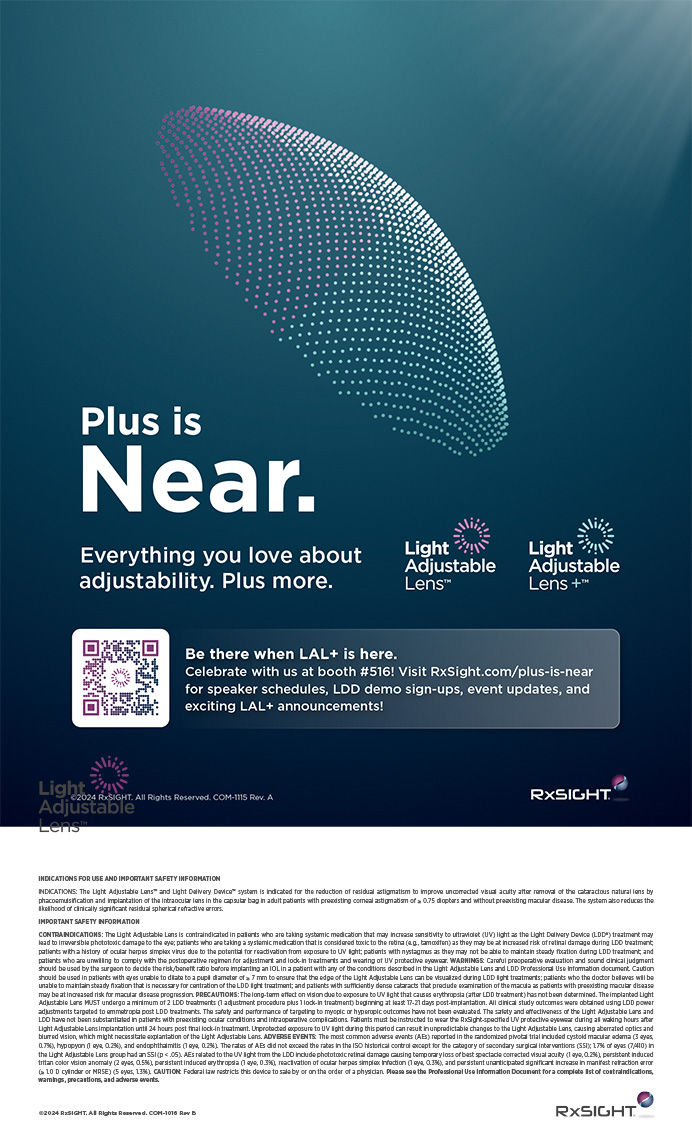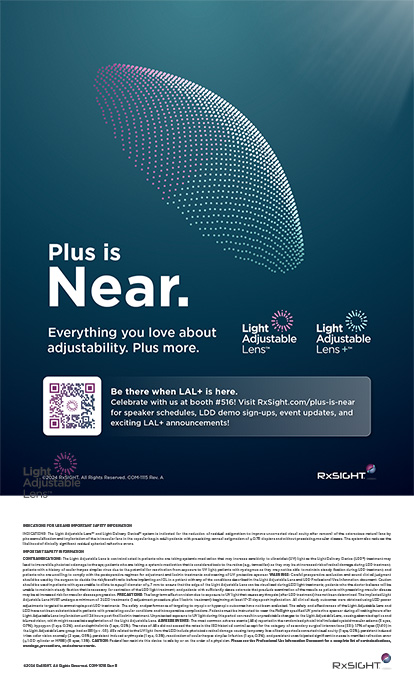Now that the Centers for Medicare & Medicaid Services have ruled that Medicare patients may have access to premium refractive IOLs, it is important for the general ophthalmologist with a successful cataract practice to offer patients the full spectrum of lens options. Making the jump from traditional cataract surgery to refractive cataract surgery, however, is not easy. An ophthalmologist must understand that the surgery surrounding the implantation of these lenses is refractive surgery, and therefore excellent refractive outcomes are required. The patients who elect to pay out of pocket for a premium IOL and its implantation expect to achieve the best result possible. They need to be thought of as refractive surgery patients, not merely cataract surgery patients. This article is a primer on how to transform your cataract practice to a refractive surgery practice. PEARL NO. 1. ACHIEVE POSTOPERATIVE REFRACTIVE ACCURACY
Being able to deliver a desired postoperative refractive result is important for the optimum performance of refractive IOLs and patients' satisfaction. The single most important practice upgrade in achieving accurate IOL calculations is moving away from applanation A-scan and toward either immersion A-scan or, if possible, the IOLMaster (Carl Zeiss Meditec, Inc., Dublin, CA). The IOLMaster is a noncontact optical coherence biometric device that more accurately measures axial lengths via light. Although it is significantly more accurate than ultrasound A-scan, it does not work well in eyes with severe cataracts, particularly posterior subcapsular and dense cataracts, which limit the view into the eye. In my practice, I can use the IOLMaster 90 of the time for cataract patients, and I reserve the A-scan ultrasound for the remaining patients or in situations where I want to double check the IOLMaster's measurements. When calculating the power of an IOL, it is critical to use a newer-generation theoretical formula (eg, Hoffer Q, SRK-T, Holladay 1 and 2, Haigis) and not a regression formula.1 It is also important to track your results and then personalize the A-constant you use for your lens calculations. For patients who have undergone prior corneal refractive surgery, lens calculations are far more difficult to establish and require more detailed methods. PEARL NO. 2. REDUCE PREEXISTING CORNEAL ASTIGMATISM
Every incision made in the cornea has the potential of affecting its astigmatism. For routine cataract surgery, what is the effect of your incision? For most surgeons, cutting a 2.5- to 3.0-mm self-sealing corneal incision creates a flattening effect of approximately 0.25 to 0.50 D at the axis of the incision.2 If the patient has a small amount of preexisting corneal astigmatism at the site of your planned incision, your incision itself may be enough to reduce or eliminate the cylinder. However, a considerable percentage of patients will have significant corneal astigmatism that requires specific treatment.3 Learning to use limbal relaxing incisions (LRIs) at the time of cataract surgery is an effective way to reduce preexisting corneal astigmatism and achieve postoperative emmetropia. Topography is the most helpful way to properly understand the extent of an eye's corneal astigmatism and will make your LRI planning more accurate. Excellent nomograms and instructions are available from some of the pioneers of LRIs, including Louis D. "Skip" Nichamin, MD4; Doug D. Koch, MD5; and Jim P. Gills, MD6; among others. Because the correction of preexisting corneal astigmatism is not a covered benefit of Medicare and most insurance plans, patients pay out of pocket for LRIs and similar procedures. Practicing the technique of LRIs as well as honing your own nomogram will help you deliver consistent results (Figure 1). PEARL NO 3. FIX POSTOPERATIVE REFRACTIVE SURPRISES
It is not always possible to deliver postoperative emmetropia due to variations in lens calculations, labeling, and positioning as well as ocular healing. In these patients, it is helpful to have methods to address postoperative refractive surprises. For small spherical residual refractive errors, implanting a piggyback IOL into the ciliary sulcus is an easy option for most cataract surgeons. Corneal refractive surgery can be an accurate way to correct residual refractive errors. For postoperative hyperopic surprises, the use of conductive keratoplasty (CK; Refractec, Inc., Irvine, CA) is a viable option that is well within the skill set of most general ophthalmologists. For those with access to an excimer laser, surface ablation or LASIK is very accurate. Surgeons without an excimer laser should consider teaming up with a local refractive surgeon who has one. PEARL NO. 4. START WITH PATIENTS WHO HAVE SIGNIFICANT CATARACTS
For your first few refractive IOL patients, start with those who have significant cataracts. A patient whose preoperative vision is 20/100 or worse will likely be happy once his visual axis is cleared. As one such patient put it to me, "Anything is an improvement!" These patients already have problems with acuity, contrast, glare, halos, and color perception; even a complicated surgery by a first-year resident would probably result in an improvement in vision (Figure 2). Once you feel that you have honed your refractive results, consider performing refractive lens exchange on precataractous patients. These individuals already have vision that is correctable to 20/20 or close to it, and, as such, they will be far more demanding of precise postoperative results. PEARL NO. 5. CHOOSE THE CORRECT PATIENTS
To further stack the odds in your favor, initially choose patients who are hyperopic with low amounts of corneal astigmatism. These patients rely on glasses for all distances preoperatively. The elimination of spectacles for even part of their visual needs is a huge improvement for them. Patients' personalities are also a factor. The perfectionist mentality is fine for the surgeon, but is best avoided in patients. I tell them that there is no substitute for the fountain of youth and that no surgery can make them see like teenagers again. An easygoing mindset goes a long way toward achieving postoperative satisfaction for both the patient and the surgeon. PEARL NO. 6. DELIVER CLEAR CORNEAS
Refractive surgery patients want clear vision, and that requires clear corneas. It is simply unacceptable to routinely induce corneal edema, Descemet's folds, and massive inflammation from surgery. Techniques to protect the corneal endothelium and minimize the phaco energy must be employed. Good-quality viscoelastics, mechanical nuclear disassembly via phaco chop, and phaco power modulations are all helpful in achieving consistently clear corneas immediately after surgery (Figure 3). PEARL NO. 7. MINIMIZE COMPLICATIONS WITH SOFT I/A
If you perform accurate IOL calculations, reduce the corneal astigmatism, remove the cataract with minimal phaco energy, but then break the capsular bag during cortical cleanup, the patient's refractive result is jeopardized. One of the most important recent innovations in cataract surgery is the development of the silicone-coated Soft I/A Tip (Microsurgical Technologies, Redmond, WA), which prevents any metal-to-capsule contact. The silicone tip is far gentler to the posterior capsule than steel. In my hands, this device has not damaged a single capsule in 100 cases (Figure 4). PEARL NO. 8: PREVENT CYSTOID MACULAR EDEMA WITH NSAIDS
It has been shown that the perioperative use of topical NSAIDs is important for the prevention and treatment of cystoid macular edema.7 The selection of one brand of NSAID over another is clearly a subject for another article, but you should be using your choice of therapy for all cataract and lens surgery patients. It is hard to explain to a patient why he does not see well, although you chose the optimum IOL, eliminated his astigmatism, and performed an excellent surgery. Preventing cystoid macular edema is as important as forestalling intraoperative complications. PEARL NO. 9. CHOOSE THE RIGHT IOL
There are currently three refractive IOLs that address presbyopia and are approved by the FDA. They are the ReZoom multifocal IOL (Advanced Medical Optics, Inc., Santa Ana, CA), the Crystalens accommodating IOL (Eyeonics, Inc., Aliso Viejo, CA), and the AcrySof Restor IOL (Alcon Laboratories, Inc., Fort Worth, TX). Each of these IOLs addresses presbyopia differently. The surgeon must know these differences and evaluate patients to determine if they are appropriate candidates for each. I have found that patients need time, perhaps months, to neuroadapt to these new IOLs. PEARL NO. 10. UNDERPROMISE AND OVERDELIVER
The goal of any refractive surgery is primarily to meet or exceed the patients' expectations. Making sure that they have a realistic expectation of the limits of refractive IOL surgery is important, as no surgery is perfect. A 65-year-old patient does not expect a plastic surgeon to make her look 25 years old again; rather, she expects to look better. Similarly, we need to help our 65-year-old patients understand that they will not be able to see as they did when they were 25, but we will certainly help them see better. Section Editor Eric D. Donnenfeld, MD, is a partner in Ophthalmic Consultants of Long Island and is Co-Chairman of Corneal and External Disease at the Manhattan Eye, Ear & Throat Hospital in New York. Dr. Donnenfeld may be reached at (516) 766-2519; eddoph@aol.com.
Uday Devgan, MD, is in private practice at the Maloney Vision Institute in Los Angeles. Dr. Devgan is Acting Chief of Ophthalmology at Olive View-UCLA Medical Center and Assistant Clinical Professor at the UCLA Jules Stein Eye Institute. He is a paid consultant to Advanced Medical Optics, Inc., and Bausch & Lomb and has received award funds from Alcon Laboratories, Inc. Dr. Devgan may be reached at (310) 208-3937; devgan@ucla.edu.
| 

